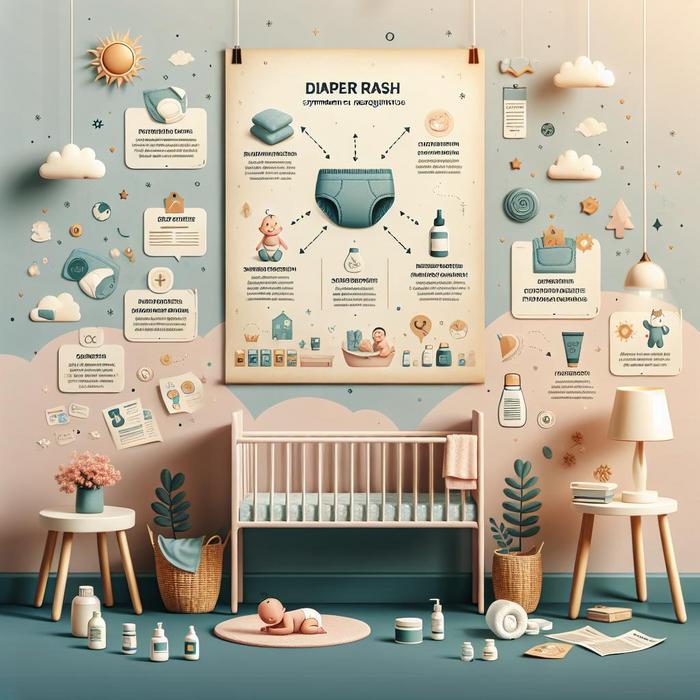Recognizing Symptoms of Diaper Rash
A baby’s skin is sensitive and can easily become irritated, especially in the diaper area. Understanding what the signs of a diaper rash look like is essential. This will ensure that you can address the issue promptly.
- Red, puffy skin: The most obvious symptom of diaper rash, the skin will appear red and swollen in the affected area.
- Dryness or peeling: The skin may start to dry and peel off due to irritation.
- Discomfort: The baby could show signs of discomfort, especially during diaper changes.
Although these symptoms can be disturbing for both the baby and the parents, there are several effective treatments and diaper rash remedies available.
Effective Treatments for Diaper Rash
When it comes to treating a diaper rash, the goal is to keep the baby’s skin as dry and clean as possible. You should change your baby’s diaper often, and give them some diaper-free time each day to let the skin air out. However, most rashes need additional treatment.
Over-the-counter creams and ointments are usually the first course of treatment. Some creams contain zinc oxide and protect the skin from moisture. On the other hand, petroleum-based lotions create a barrier on the skin, prevent further irritation and allow the skin to heal. As with any treatments, consult your pediatrician before trying anything new.
CHLA advises that in severe cases, a medical professional may prescribe a stronger ointment or cream.
Home Remedies for Diaper Rash
Besides the common medical treatments, there are also several home remedies for diaper rash that you can try, including the following:
- Bathing: Give your baby a warm bath with mild soap and let them air dry. This can soothe the irritated skin and prevent bacteria from growing.
- Breast milk: If you are breastfeeding, apply a few drops of breast milk on the rash. Breast milk has antimicrobial properties that can help heal the rash naturally.
- Oatmeal: Add a tablespoon of dried oatmeal to your baby’s bath. It can help to soothe the skin and reduce inflammation.
Preventing Rashes and Ensuring Baby’s Safety
Prevention is the best cure when it comes to diaper rashes. There are quite a few measures you can take to prevent diaper rash:
- Change diapers frequently: The best action you can take is to keep your baby dry and clean as much as possible. Don’t let your baby sit in a wet or dirty diaper.
- Use the right products: Use baby products that are gentle on your baby’s skin. Stay away from products with harsh chemicals.
- Create a safe play space: Let your baby have some diaper-free time each day in a baby-friendly play space.
Treating and preventing diaper rash can be a simpler task when you know what to look for and how to handle it. Remember, a baby’s skin is delicate, and it’s important to ensure their safety and comfort at all times.
Additional Tips for Diaper Rash Treatment and Prevention
Apart from the above-stated measures, here are some additional tips to aid treatment and prevention of diaper rash:
- Opt for Fragrance-Free Diapers: Many diapers contain fragrances and other chemicals, which could worsen or even cause diaper rash. Opting for fragrance-free and hypoallergenic diapers can help prevent such skin irritations.
- Try Different Diaper Brands: If your baby tends to get rashes frequently, it might be worthwhile to try a different brand of diapers. Some babies’ skin may react less to certain brands.
- Use Unscented Wipes: Heavily scented wipes can also irritate a baby’s sensitive skin. Choose unscented or hypoallergenic wipes, or simply use a clean cloth with warm water.
When to Seek Medical Advice
If your baby’s diaper rash continues to worsen or doesn’t seem to improve, it’s crucial to seek medical advice. According to the Mayo Clinic, signs that you should contact a doctor or nurse practitioner include:
- The rash lasts longer than two days or seems to be getting worse.
- The rash spreads outside the diaper area, to the abdomen or thighs, for example.
- Your child also has a fever or seems lethargic.
- Pus, blisters, or other severe signs of inflammation appear.
The Role of Nutrition & Diet in Diaper Rash Prevention
Nutrition and diet play a crucial role in preventing diaper rash. Certain foods may irritate the baby’s skin, leading to diaper rash. Therefore, it’s recommended to introduce new foods into your baby’s diet gradually.
According to Seattle Children’s, you should watch for any food allergies that could potentially be causing the rash. However, these are less common. Rashes caused by food allergies are also usually accompanied by other symptoms, like diarrhea or vomiting.
Final Tips for Families
Finally, it’s important to remember that if you’re a new parent, you’re not alone in dealing with diaper rashes. Plenty of resources are available to help you learn more about this common issue.
KidsHealth and Nationwide Children’s offer a wealth of information on the topic. You can also join parenting communities online or locally, where you’ll find parents who have dealt with similar concerns.
Keeping your baby comfortable is a learning process, especially in their first few months. Take each day as it comes, do your best, and you’ll soon become a pro at handling all the minor challenges parenting throws your way.

